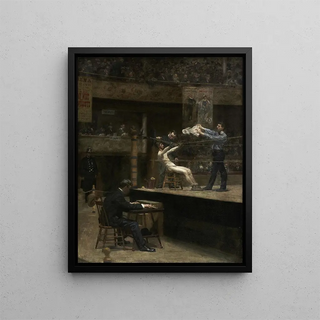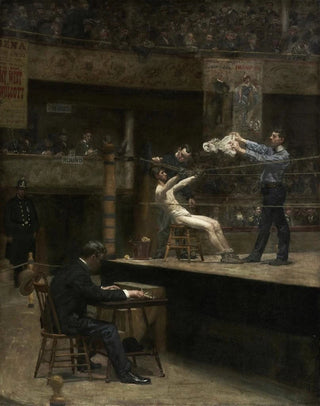Art print | Between the Towers - Thomas Eakins Source: Reproduction | Entre les tours - Thomas Eakins


View from behind

Frame (optional)
The artwork "Entre les tours" by Thomas Eakins is a true invitation to immerse oneself in the fascinating world of the late 19th century. This painting, which evokes the encounter between man and architecture, unfolds an atmosphere filled with serenity and reflection. The viewer's gaze is irresistibly drawn to the meticulous details of the characters who evolve within this urban landscape, thus capturing a suspended moment in time. Eakins, with his keen sense of observation, manages to capture not only the physicality of the human figures but also the very essence of their interaction with the surrounding environment. Every element of the composition seems to tell a story, a visual narration that invites contemplation.
Style and uniqueness of the artwork
Eakins' style is distinguished by striking realism, blending precise pictorial technique with profound human sensitivity. In "Entre les tours," the lines and shapes harmoniously combine to create an atmosphere that is both dynamic and soothing. The play of light and shadow, typical of his approach, emphasizes volumes and textures, giving the work an almost sculptural dimension. The characters, although frozen in their activity, seem animated by a rich inner life, with each expression and posture revealing a part of their psychology. This ability to transcend simple framing to offer an emotional reading of the scene is one of Eakins' hallmarks, making this artwork a shining example of his artistic genius.
The artist and his influence
Thomas Eakins, an emblematic figure of American art, managed to mark his era with an innovative vision that profoundly influenced the artistic landscape. His training in Paris, in contact with European masters, sharpened his gaze and refined his technique, but it was his return to the United States that allowed him to develop a unique style rooted in American reality. Eakins always sought to explore the human condition, focusing on the psychology of characters and their interaction with their environment. His commitment to representing the truth, both in form and content, paved the way for many artists who followed in his footsteps. The modernity of his

Matte finish

View from behind

Frame (optional)
The artwork "Entre les tours" by Thomas Eakins is a true invitation to immerse oneself in the fascinating world of the late 19th century. This painting, which evokes the encounter between man and architecture, unfolds an atmosphere filled with serenity and reflection. The viewer's gaze is irresistibly drawn to the meticulous details of the characters who evolve within this urban landscape, thus capturing a suspended moment in time. Eakins, with his keen sense of observation, manages to capture not only the physicality of the human figures but also the very essence of their interaction with the surrounding environment. Every element of the composition seems to tell a story, a visual narration that invites contemplation.
Style and uniqueness of the artwork
Eakins' style is distinguished by striking realism, blending precise pictorial technique with profound human sensitivity. In "Entre les tours," the lines and shapes harmoniously combine to create an atmosphere that is both dynamic and soothing. The play of light and shadow, typical of his approach, emphasizes volumes and textures, giving the work an almost sculptural dimension. The characters, although frozen in their activity, seem animated by a rich inner life, with each expression and posture revealing a part of their psychology. This ability to transcend simple framing to offer an emotional reading of the scene is one of Eakins' hallmarks, making this artwork a shining example of his artistic genius.
The artist and his influence
Thomas Eakins, an emblematic figure of American art, managed to mark his era with an innovative vision that profoundly influenced the artistic landscape. His training in Paris, in contact with European masters, sharpened his gaze and refined his technique, but it was his return to the United States that allowed him to develop a unique style rooted in American reality. Eakins always sought to explore the human condition, focusing on the psychology of characters and their interaction with their environment. His commitment to representing the truth, both in form and content, paved the way for many artists who followed in his footsteps. The modernity of his






